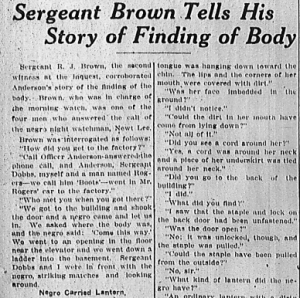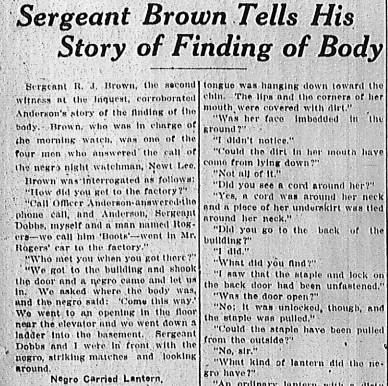 Another in our series of new transcriptions of contemporary articles on the Leo Frank case.
Another in our series of new transcriptions of contemporary articles on the Leo Frank case.
Atlanta Georgian
Wednesday April 30th, 1913
Sergeant R. J. Brown, the second witness at the inquest, corroborated Anderson’s story of the finding of the body. Brown, who was in charge of the morning watch, was one of the four men who answered the call of the negro night watchman, Newt Lee.
Brown was interrogated as follows:
“How did you get to the factory?”
“Call Officer Anderson answered the phone call, and Anderson, Sergeant Dobbs, myself and a man named Rogers—we call him ‘Boots’—went in Mr. Rogers’ car to the factory.”
“Who met you when you got there?”
“We got to the building and shook the door and a negro came and let us in. We asked where the body was and the negro said: ‘Come this way.’ We went to an opening in the floor near the elevator and we went down a ladder into the basement. Sergeant Dobbs and I were in front with the negro, striking matches and looking around.
Negro Carried Lantern.
“The negro was with us, carrying a dim lantern. We found the body lying face downward, the arms folded underneath. I looked at the body and said: ‘For Heavens’ sake; It is only a child.’ I turned the body over and it was cold and stiff. I couldn’t tell whether it was white or colored. I rubbed the dirt and trash and cinders from her face with a piece of paper, and then I said that she was a white girl and others said she was colored. It was not determined until Call Officer Anderson pulled her stocking down and looked at her leg. Then we saw that she was white.”
“Did you see any indications of the body having been dragged?”
“There was an impression on the pathway over which we had come as though something had been dragged along there, but the light was very dim and it was hard to tell.”
“Did you find any paper?”
“A couple of notes were picked up. I think one was found by Sergeant Dobbs and one was found by me.”
“Was the inside of the girl’s mouth clean?”
“It was covered with dirt.”
“Was her mouth open?”
“Her mouth was open and the tongue was hanging down toward the chin. The lips and corners of her mouth were covered with dirt.”
“Was her face imbedded in the ground?”
“I didn’t notice.”
“Could the dirt in her mouth have come from lying down?”
“Not all of it.”
“Did you see a cord around her?”
“Yes, a cord was around her neck and a piece of her underskirt was tied around her neck.”
“Did you go to the back of the building?”
“I did.”
“What did you find?”
“I saw that the staple and lock on the back door had been unfastened.”
“Was the door open?”
“No; it was unlocked, though, and the staple was pulled.”
“Could the staple have been pulled from the outside?”
“No, sir.”
“What kind of lantern did the negro have?”
“An ordinary lantern with a dirty globe.”
How Negro Found Body.
“What did Lee say to you?”
“He said he knew nothing of the girl’s death. He said he rarely went into the basement and that on this occasion he went to use the toilet. He said after he had used the toilet he saw the girl’s body lying over there.”
“Did he say how far she was from the toilet?”
“Not in figures, but the toilet is 25 feet from where the body lay.”
“Did he say how the body was lying?”
“No, sir, not to me.”
“Did he say he had touched the body?”
“Not in my presence.”
“Did you call Mr. Frank over the telephone?”
“No, I guarded Lee while Anderson called him.”
“How long did Anderson wait on Mr. Frank?”
“He waited some time. He asked central to hurry the call. He told central that a woman had been murdered there and that he was very anxious to get Mr. Frank.”
“What kind of clothing did the girl wear?”
“A kind of a purple dress.”
Body Not Obscured.
“Could you see the body from where the negro, Lee, was standing when he said he saw it?”
“I can’t say, but to do that one would have to look right close.”
“Did the corner of the little room obstruct the view of the body from the toilet?”
“I think it would have, of the head and shoulders, not of the legs.”
“Was the cord around her neck tied in front or behind?”
“I think it was looped in the rear.”
“Did you see evidence of a struggle?”
“I don’t know that I did. We went down into the basement hurriedly and right up to where the negro said the body was.”
“Did you start an investigation?”
“We looked around as much as we could, and then notified Chief Lanford, and his men came and took charge of it.”
“Did you go upstairs?”
“No, sir.”
“Were the gas jets in the basement lighted?”
“No.”
“Did you use the elevator?
“No, we used the ladder altogether.”
“Did the negro say that the elevator had been used during the evening?”
“No.”
“Was anything found upstairs when you went up to telephone?”
“No, we didn’t look around there much. We had no light.”
“How far did the girl’s tongue protrude from her mouth?”
“This far.” (The witness measured about an inch and a half on his fingers.)
“Was the body cold?”
“Yes, and a bubbly streak was coming from her nostrils. Blood was running from her ears and her mouth.”
Dr. J. W. Hurt, county physician, who performed the autopsy on the dead girl, asked the witness several questions relating to the condition of the body below the shoulders.
He asked:
“When the stocking was pulled down, did you loosen any strappings to do so?”
“No, the supporter from the corset was loose.”
“Was the catch on the supporter broken, or only unfastened?”
“I don’t think it was broken.”
“Did Anderson loosen the supporter?”
“No.”
“Did he use any violence in examining the body?”
“No.”
Dr. Hurt then turned the witness back over to the jury.
Draw Knot About Neck.
“How was the cord tied about her neck?”
“It was looped and tied with a draw knot.”
“What else was around her neck?”
“Two pieces of her underskirt had been torn away, tied together and bound around her neck.”
“How tight was the cord drawn?”
“Tight enough to have chocked her to death.”
“Which was tied on first?”
“I think the cord was.”
“What do you think caused her death?”
“Strangulation.”
* * *
Atlanta Georgian, April 30th 1913, “Sergeant Brown Tells His Story of Finding of Body,” Leo Frank case newspaper article series (Original PDF)
